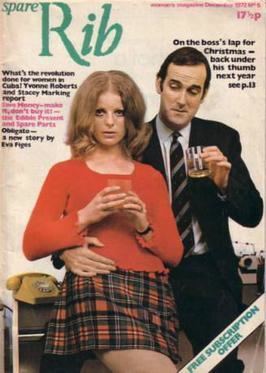Categories Feminist Magazine Final issue 1993 Language English | Year founded 1972 | |
 | ||
Editor Collective from late 1973 | ||
Spare rib magazine feminism talkingwith angela phillips
Spare Rib was a second-wave feminist magazine in the United Kingdom that emerged from the counter culture of the late 1960s as a consequence of meetings involving, among others, Rosie Boycott and Marsha Rowe. Spare Rib is now recognised as an iconic magazine, and a place which shaped debate about feminism in the UK. It contained new writing and creative contributions which challenged stereotypes and supported collective solutions. The magazine existed between 1972 and 1993.
Contents
History
Spare Rib's first issue was published in June 1972. At the time, some newsagents refused to stock it, including W. H. Smith. Selling at first around 20,000 copies per month, it was circulated more widely through women's groups and networks.
Its purpose, as described in its editorial, was to investigate and present alternatives to the traditional gender roles for women of virgin, wife or mother.
The name Spare Rib started as a joke, with its play on words about the Biblical Eve fashioned out of Adam’s rib, implying that a woman had no independence from the beginning of time. This held the witty, subversive connotations the editors had been looking for.
The Spare Rib Manifesto stated:
"The concept of Women’s Liberation is widely misunderstood, feared and ridiculed. Many women remain isolated and unhappy. We want to publish Spare RIB to try to change this. We believe that women’s liberation is of vital importance to women now and, intrinsically, to the future of our society. Spare RIB will reach out to all women, cutting across material, economic and class barriers, to approach them as individuals in their own right".
Early articles were linked closely with left-leaning political theories of the time, especially anti-capitalism and the exploitation of women as consumers through fashion. The covers were often of a striking design.
As the women's movement evolved during the 1970s, the magazine became a focus for sometimes acrimonious debate between the many streams that emerged within the movement, such as socialist feminism, radical feminism, revolutionary feminism, lesbian feminism, liberal feminism and black feminism. It included contributors from well-known international feminist writers, activists and theorists as well as the stories of ordinary women in their own words.
Spare Rib articles tacked many different threads of feminism from many different angles. Subjects included: “liberating orgasm”, “kitchen sink racism”, anorexia and the practice of female genital mutilation. The ensuing debates were often acrimonious, and the magazine reflected the sometimes turbulant debates within the collective on how best to tackle issues such as sexuality and racism.
Suffering from the effects of falling subscriptions and advertising revenue Spare Rib ceased publication in 1993.
It was announced by The Guardian in April 2013 that the magazine was due to be relaunched, with the journalist Charlotte Raven at the helm. It was subsequently announced that while a magazine and website were to be launched, it would now have a different name.
In May 2015 the British Library put its complete archive of Spare Rib online. The archive is presented with new views on the subject matter and themes curated by expert commentators. The British Library website describes the value of Spare Rib for current readers and researchers:
"Spare Rib was the largest feminist circulating magazine of the Women’s Liberation Movement (WLM) in Britain of the 1970s and 80s. It remains one of the movement’s most visible achievements. The trajectory of Spare Rib charted the rise and demise of the Women’s Liberation Movement and as a consequence is of interest to feminist historians, academics and activists and to those studying social movements and media history".
Editors
Spare Rib became a collective by the end of 1973 (see Spare Rib Reader, edited by Marsha Rowe, and Rosie Boycott, A Nice Girl Like Me). The collective editorial policy was to: "collectively decide on articles that they publish, and work closely with the contributors. Accept articles from men only when there is no other resource available. 35p per copy."
Design
According to Marsha Rowe, one of the original magazine designers, the magazine design, which resulted in so many iconic and striking covers was born out of necessity. It had to look like a women’s magazine, yet with contents that did not reflect the conformist stereotyping of women. Spare Rib covers were often controversial. It had to suggest the familiarity of women’s magazines – 'like a good friend, intimate, loyal, supportive – while also being challenging, questioning, exciting and radical'. The designers had to transform the name Spare Rib into a magazine title. They had to create the front cover look, and an overall style for the pages inside the magazine. The design had to be both stable and flexible, to allow for future change while retaining the feel and basic identity. Integral to every decision was cost. "Money and professionalism went hand in hand."
New, young illustrators and photographers were keen to work for the magazine, enjoying the challenge of finding a visual language to express the new ideas of the magazine. Finding non-sexist advertising in accordance with the values of the magazine was another challenge.
